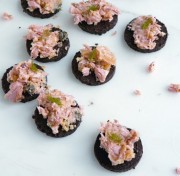Recipe
November 8, 2010
Salmon & Pumpernickel Canapés Recipe

Step 1: Preheat the oven to 300°F.
Step 2: Set a large nonstick frying pan over high heat, and when hot, cover the base with a film of olive oil. Add the salmon quickly to the hot pan, skin side down, and reduce the heat to medium. Cook for a couple of minutes, then turn and cook it for a minute or two on the other side.
Step 3: Add the capers, cover the pan and cook until the salmon has just cooked through. This should take only a couple of minutes, but will depend on the thickness of the fillet. Introduce the tip of a knife into the thickest part of the salmon to check for doneness.
Step 4: Transfer the salmon to a plate and pull away and discard the skin.
Step 5: Add a tbsp of water to the frying pan and scrape up the pan juices and capers, then add them to the salmon. Add the fennel, white pepper and a little salt. Flake the fish or mash to a rough paste with a fork, checking for bones as you do so.
Step 6: Spoon the salmon paste into the buttered ramekins, press down flat and cover with 2/3 of the clarified butter. Transfer to a shallow ovenproof dish, add boiling water so that it comes halfway up the sides of the ramekins and cook in the preheated oven for 10 minutes. Leave to cool.
Step 7: Pour the remaining clarified butter over the salmon until it is completely submerged. Put in the fridge to set.
Step 8: Take the potted salmon out of the fridge 20 minutes before serving to bring back to ambient temperature. Serve either straight from the pots or turn out onto a plate so that the butter layer is underneath. Top each with a fennel frond and serve with a few slices of the cucumber.
Reprinted with permission from Lindy Wildsmith’s Cured (2010 Jacqui Small).

Directions
Yield:
Step 1: Preheat the oven to 300°F.
Step 2: Set a large nonstick frying pan over high heat, and when hot, cover the base with a film of olive oil. Add the salmon quickly to the hot pan, skin side down, and reduce the heat to medium. Cook for a couple of minutes, then turn and cook it for a minute or two on the other side.
Step 3: Add the capers, cover the pan and cook until the salmon has just cooked through. This should take only a couple of minutes, but will depend on the thickness of the fillet. Introduce the tip of a knife into the thickest part of the salmon to check for doneness.
Step 4: Transfer the salmon to a plate and pull away and discard the skin.
Step 5: Add a tbsp of water to the frying pan and scrape up the pan juices and capers, then add them to the salmon. Add the fennel, white pepper and a little salt. Flake the fish or mash to a rough paste with a fork, checking for bones as you do so.
Step 6: Spoon the salmon paste into the buttered ramekins, press down flat and cover with 2/3 of the clarified butter. Transfer to a shallow ovenproof dish, add boiling water so that it comes halfway up the sides of the ramekins and cook in the preheated oven for 10 minutes. Leave to cool.
Step 7: Pour the remaining clarified butter over the salmon until it is completely submerged. Put in the fridge to set.
Step 8: Take the potted salmon out of the fridge 20 minutes before serving to bring back to ambient temperature. Serve either straight from the pots or turn out onto a plate so that the butter layer is underneath. Top each with a fennel frond and serve with a few slices of the cucumber.
Reprinted with permission from Lindy Wildsmith’s Cured (2010 Jacqui Small).


